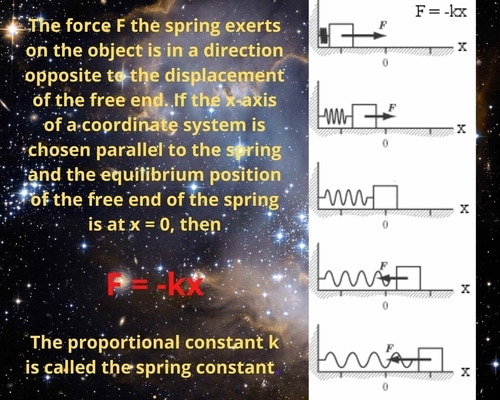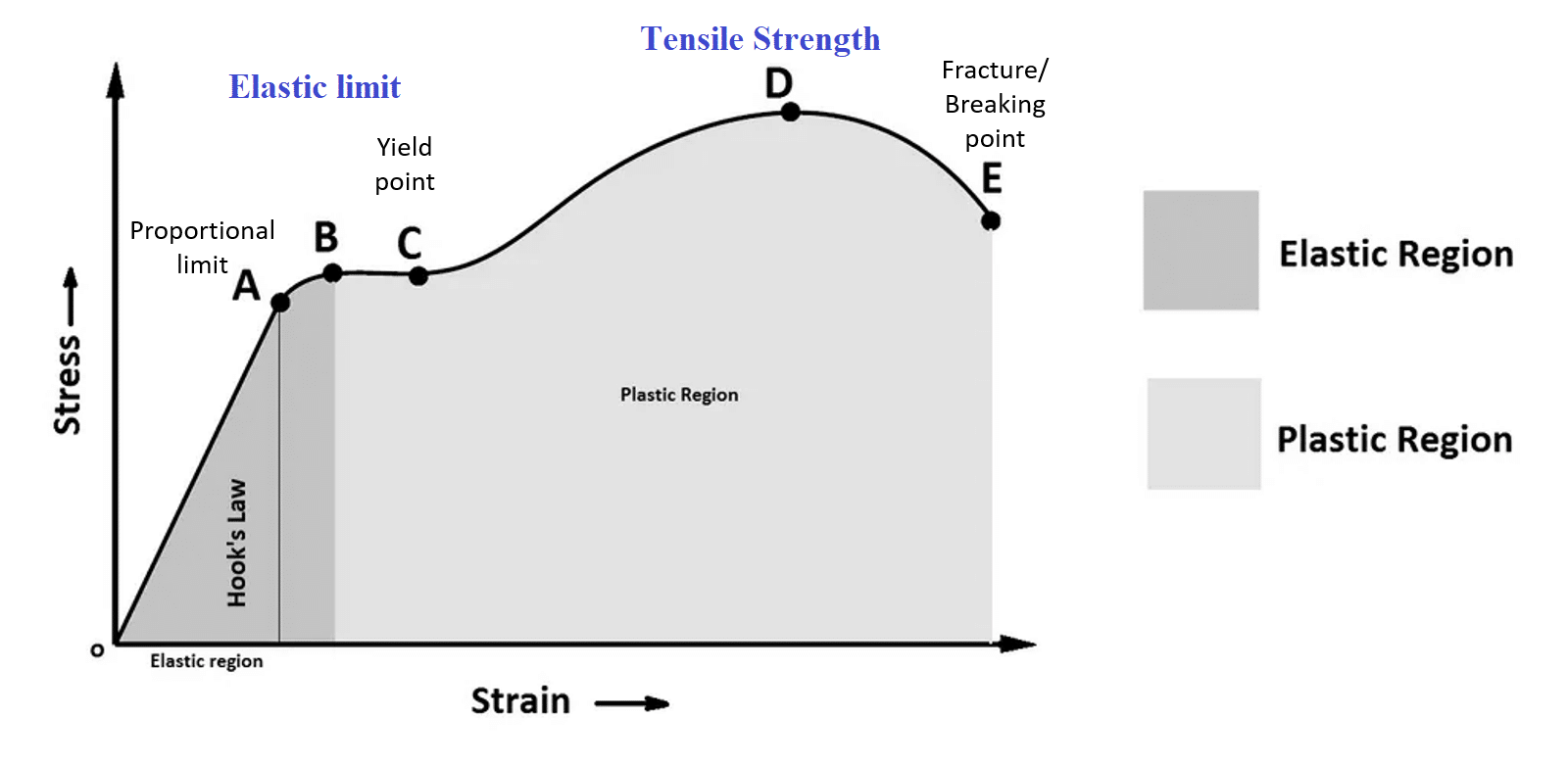The spring constant, k, is a measure of the stiffness of the spring. It depends on the spring and the material. The bigger the spring constant, the stiffer and more difficult the spring is to extend. Hooke’s law describes the extension of an elastic item, such as a spring. According to Hooke’s law, the applied force F equals the constant k multiplied by the displacement or change in length x, as illustrated in equation 1.
F=-kx —– (1)
- F is the force in newtons (N)
- k is the ‘spring constant’ in newtons per meter (N/m)
- x is the extension in meters (m)
- The negative sign indicates that the spring’s restoring force is in the opposite direction of displacement.
- This equation holds as long as the limit of proportionality is not exceeded.

When an object, such as a spring, is stretched or squished, it stores elastic potential energy.
When an object, such as a spring, is stretched, the additional length is referred to as its extension.
Hooks law states that the extension of a spring is directly proportionate to the force exerted, as long as the proportionality limit is not exceeded.
Hooke’s Law is followed to the limit of proportionality. Stretching force and extension are no longer directly proportional beyond this point, and the graph begins to curve. When a material is stretched beyond what is known as the elastic limit, it does not return to its original length when the force is removed. The force exerted by a spring (spring force) is referred to as a restoring force because it constantly acts to return the spring to equilibrium.

Table of Contents
Types of Deformation
Deformation can be classified into two types:
Elastic Deformation: In elastic deformation, when the stress is removed, the material returns to its original dimensions prior to the application of the load. The distortion is transient and reversible.
Plastic deformation: In plastic deformation, when a material is subjected to a high level of stress and tension is released, the material does not return to its former position. There is a permanent irreparable deformity. A material’s elastic limit is the smallest amount of stress that causes plastic deformation.
Elastic modulus
The elastic modulus (also known as Young’s modulus) is a quantity that indicates how resistant a material is to being elastically deformed. It is known as the stress-to-strain ratio. The higher the Young’s modulus of a material, the stiffer it is. Elastic modulus is a material attribute. It is used to forecast an object’s elongation or compression before the elastic limit is reached. Young’s modulus Y is the ratio of the force per unit area F/A, often known as the stress, to the fractional change in length L/L before the elastic limit is reached.
Y = (F/A)/(∆L/L)
Concept of Spring Force
Consider a spring with one end attached to a hook and the other attached to an object with mass m and allowed to hang down vertically. In this case, the object will be subject to two forces. When a spring is stretched it moves; when it is compressed, it contracts. Then it reaches its equilibrium point. As a result, a spring exerts an equal and opposite force on a body, compressing or stretching it.
- One force will be the spring’s restoring force, which will be directed upward.
- The other force will be gravity acting on the mass in a downward direction.

If the mass does not move, it will remain at rest in an equilibrium position with a zero net force.
Spring periodic oscillations demonstrate simple harmonic motion.
The acceleration () in simple harmonic motion is proportional to the displacement (x) from equilibrium in the direction of the equilibrium location.
In SHM, the restoring force is proportional to the displacement x. This restorative force and displacement are always polar opposites. The equation for force can be formed using a proportionality constant k.
Fx = – k x (Spring force formula)
Numerical Problems (Spring Constant)
The spring constant is a physical constant that describes the amount of force necessary to compress or expand a spring. Understanding basic concepts such as Hooke’s law, elastic potential energy, and the relationship between force, displacement, and spring constant is required when solving problems requiring spring constant in physics. Here are some examples of typical problems that can be solved with these concepts:
- Calculating force: Using Hooke’s law, you can calculate the force applied to a spring given its spring constant and displacement: F = kx, where F is the force, k is the spring constant, and x is the displacement.
- Calculating displacement: Using Hooke’s law, you can compute displacement given the spring constant and the force applied to a spring: x = F/k, where x is the displacement and F is the force.
- Calculating the spring constant: If you know the force applied to a spring and its displacement, you can use the equation: k = F/x, where k is the spring constant and x is the displacement.
- Elastic potential energy: You can use the spring constant and the displacement to calculate the elastic potential energy stored in a spring using the equation: U = 1/2 kx^2, where U is the elastic potential energy, k is the spring constant, and x is the displacement.
Related Links
Metal Definition & Meaning
Kinetic Energy Formula
Stress in Physics| Definition and Easy Examples
Summary
The spring constant, k, is a measure of the stiffness of the spring. It changes according to the spring and the material. The higher the spring constant, the stiffer the spring and the harder it to stretch.
Frequently Asked Questions
1. What is spring constant in simple words?
The spring constant is a value that represents how stiff or resistant a spring is to being compressed or stretched. In simple terms, the spring constant measures how much force you need to apply to a spring in order to make it compress or stretch by a certain amount.
Think of a spring as a rubber band. If you try to stretch a rubber band, it will become longer. If you apply more force to the rubber band, it will stretch even more. The spring constant is a value that tells you how much force you need to apply in order to stretch the rubber band by a certain amount. If the spring constant is high, it means that you need to apply a lot of force to make the rubber band stretch. If the spring constant is low, it means that you only need to apply a small amount of force to make the rubber band stretch.
2. What is unit of spring constant in physics?
The unit of the spring constant, also known as the force constant, is newton per meter (N/m) in the SI (International System of Units). This unit represents the amount of force required to stretch or compress a spring by one meter.
In other words, if you apply a force of one newton to a spring with a spring constant of one N/m, the spring will stretch or compress by one meter. If you apply a force of two newtons to the same spring, it will stretch or compress by two meters, and so on. The relationship between the force applied to a spring and the resulting displacement is described by Hooke’s law, which states that the force applied to a spring is proportional to its displacement, with the proportionality constant being the spring constant.
More Interesting Topics
Can Work Be Negative?
Carbon Fibre Braided Composite Tubes
Flexural Strength- An Overview
- BCl3 Lewis Structure in four simple steps - November 1, 2023
- PH3 Lewis Structure in four simple steps - October 8, 2023
- PF3 Lewis structure in four simple steps - September 24, 2023



